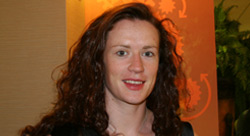Get started with Wolfram technologies, or work with us to apply computational expertise to your projects.
Questions? Comments? Get in touch: 1-800-WOLFRAM, or email us

In January of 1999, Sarah Flannery was named the Irish Young Scientist of the Year for her work in devising a highly innovative, fast and secure new algorithm for data encryption of internet and other electronic communications. The award carried with it an impressive silver trophy, a monetary sum of IR£1,000, a one-week trip to Thessaloniki, Greece, to represent Ireland at the European Contest for Young Scientists and a wave of international media attention. It is largely due to all of this interest that Sarah was asked to write about her experiences. The resulting book, In Code: A Mathematical Journey, was published in April 2000.
Sarah's project, entitled "Cryptography—A New Algorithm versus the RSA," was widely praised by both competition judges and professional cryptographers alike for its brilliant applications of number theory and its demonstration of a strong grasp of the fundamentals of cryptography. In it, Sarah compared the algorithm she developed, called the Cayley–Purser (CP) algorithm, to the RSA public key cryptosystem developed in the 1970s at MIT. Her intent was to demonstrate that the CP algorithm was much faster than and just as secure as the celebrated RSA. Along the way, however, she also discovered how "wonderfully powerful" Mathematica is. It was "great fun learning the Mathematica commands to [encipher and decipher]... just seeing it work was a real kick," she wrote.
Sarah initially undertook to explore the science of cryptography in the fall of 1997 during her Transition Year, after being introduced to the topic in a class called Mathematical Excursions taught by her father at the Cork Institute of Technology. When her science teacher, who was looking for competition participants, described the nature of the fun, excitement and experiences at the nationally known Esat Young Scientist & Technology Exhibition, Sarah "knew it would be worth doing something just for the craic to be had up in Dublin for five days." They were currently discussing cryptography in her father's class. As she had "heard Dad rave about this mathematical package called Mathematica that he made out to be the cat's pyjamas," Sarah decided that this would be an ideal opportunity to learn what this "wonderful piece of software" could do. Besides, she "had some inkling that [she] would really love programming."
In her book, Sarah includes a lively, comprehensive discussion of the fundamentals of cryptography and the underlying mathematics and number theory behind it. She gradually pulls the reader in with early presentations and explanations of some popular and some not-so-common logic and math puzzles. Readers are invited to either think their way through the introductory chapters or bypass them for a still-very-captivating description of her cryptography project and the challenges involved, which were many. Sarah's project required that she learn number theory, the necessary cryptographic ideas and programming in Mathematica so as to implement and illustrate the cryptographic schemes, all within a few months. As she learned additional number theory and the way to program the code to manipulate it, she was thrilled by how Mathematica processed "in the blink of an eye" the huge numbers common in cryptography.
Sarah entered her first project, "Cryptography—The Science of Secrecy," in the 1998 Esat competition, which earned her the Intel Excellence Award, amongst other honors. It also helped her to land a valuable work experience with Baltimore Technologies, a Dublin-based cryptography company, where she was assigned to investigate an idea for a possible new public key cryptosystem presented in an unpublished paper written by the company's founder, Michael Purser. It was following this exposure that Sarah realized she might be able to extrapolate from Purser's ideas to devise an asymmetric algorithm that exploited the noncommutative property of matrix multiplication. Whereas the RSA algorithm requires modular exponentiation of numbers from two hundred to five hundred digits in length to numbers of the same magnitude, this new algorithm would involve only modular multiplication, making it much faster.
Over the next few months, Sarah set herself to the task of learning basic matrix theory in order to construct her new algorithm, writing programs to generate examples of unfamiliar concepts and consulting her father and numerous journals for additional information. As her mathematics knowledge and programming skills increased, she determined to write cleaner, more sophisticated code after admiring the work of others that demonstrated the "wonderful flexibility of the Mathematica language." Using Mathematica, Sarah implemented both the RSA and the CP algorithms and performed comparative runtime analyses on them. Her efforts were rewarded when she was able to demonstrate successfully that the CP algorithm was 20 to 30 times faster than the RSA and to knowledgeably defend an attack on it as well. This all garnered her a first prize in the European Young Scientist Competition and a trip to attend the December 1999 Nobel Prize ceremonies in Stockholm.
Apart from her extraordinary accomplishments, Sarah considers herself to be a fairly regular girl with a wide range of hobbies and interests. She has recently completed her Irish Leaving Certificate Examinations, and although she is considering taking a year off to independently study more mathematics, she will eventually go on to a university, where she will study mathematics and computing. "I have no doubt that I am not a genius," says Sarah. However, she was fortunate to find a project topic in which she was "interested—very interested—and worked very hard." She was also fortunate enough to have her father as a mentor. He always encouraged her to learn the fundamentals, "just to think" and not to be intimidated by unfamiliar problems or topics.
Sarah's story, In Code: A Mathematical Journey, is currently for sale throughout the UK, with plans for translation and distribution in Japan, Korea, China and the United States within the year. It has so far received only excellent reviews and is already in its second printing. It can be ordered online through the Amazon.co.uk bookstore.